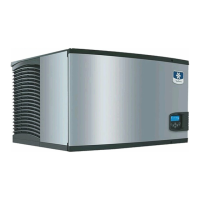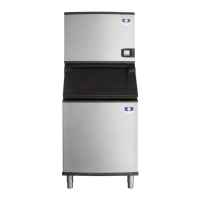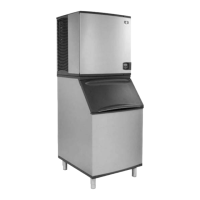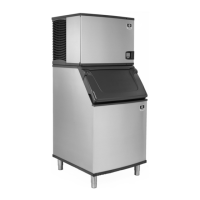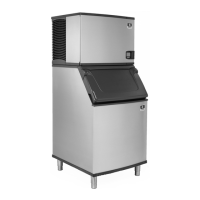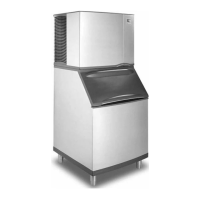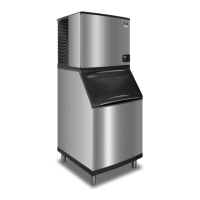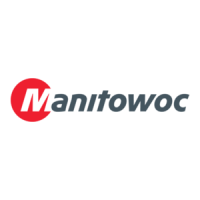Do you have a question about the Manitowoc Indigo I0300 and is the answer not in the manual?
Read and follow precautions to prevent personal injury, damage, or death when operating or maintaining equipment.
Follow electrical codes and ensure proper grounding and wiring for safe installation and operation.
Adhere to installation guidelines to prevent personal injury and ensure stability and proper function.
Follow safety guidelines to prevent injury during operation, maintenance, and cleaning.
Understand and adhere to warnings regarding misuse, abuse, neglect, and protection of children.
Details on the ice deflector's requirement for bin installation and its function.
Information on the accessory for adjusting bin level on specific models.
Guidelines for installing the ice machine on a bin, including deflector use.
Description of the two available bezels for the control panel and how to change them.
Information on the kit that directs warm exhaust air upward.
Explanation of the UV bulb system that inhibits microbial growth.
Guide to understanding the alphanumeric code used to identify ice machine models and their configurations.
Criteria for selecting an appropriate installation location for the ice machine head section.
Essential steps and conditions for proper installation of the ice machine and bin.
Data on heat rejection for air-cooled and water-cooled ice machines.
Specifications for required clearances around self-contained and remote condenser models.
Clearance specifications for QuietQube models, including top, back, and sides.
Required clearances for various condensing unit models for optimal operation.
Steps for correctly installing the ice machine bin, including leveling and securing.
Instructions for installing the air baffle on self-contained air-cooled models.
Guidelines for wiring, grounding, and circuit protection to ensure safe electrical installation.
Information on selecting appropriate wire size based on circuit ampacity.
Recommendations and considerations for using GFCI protection with the equipment.
Table detailing maximum breaker size and minimum circuit amperage for various ice machine models.
Electrical specifications for QuietQube head sections, including amperage and wire size.
Electrical specifications for ICVD condensing units, including amperage and wire size.
Instructions for low-voltage wiring between the ice machine head and ICVD condensing unit.
Guidance on correctly wiring the transformer for 208V or 240V supply to prevent failure.
Guidelines for sizing and connecting water supply and drain lines, including temperature and pressure limits.
Explanation of the built-in air gap for back-flow prevention and NSF compliance.
Specific considerations for water-cooled models when used with cooling towers.
Best practices for installing drain lines to prevent backflow and ensure proper drainage.
Instructions for installing auxiliary drains to remove moisture in high humidity areas.
Steps for installing the remote condensing unit and refrigerant line sets.
Details on refrigerant charge, line set sizing, and insulation requirements.
Warning about handling refrigerant and the need for EPA-certified technicians.
Formulas and procedures for calculating maximum remote condenser and condensing unit installation distances.
Maximum allowable tubing length, rise, and drop for line sets.
Instructions for securely mounting the condenser unit to a curb, rack, or timber.
Guidelines for routing refrigeration tubing between the ice machine and condenser, including roof penetrations.
Information on the S-Trap kit, its purpose for oil return, and tubing size compatibility.
Detailed steps for connecting the refrigeration line set, including torque specifications and leak checking.
Specific precautions for QuietQube models regarding system exposure and purging.
Procedure for pressure testing and evacuating the line set and ICVD condensing unit.
Steps to open shutoff valves for the line set and receiver service valve to allow refrigerant flow.
Instructions for connecting wiring between the condensing unit and the ice machine head section.
Procedure for leak checking the refrigeration system connections and joints.
Specifications for suction line and liquid line insulation to prevent condensation.
Guidance on moving and positioning the bin thermostat probe for correct operation.
Initial steps and responsibilities for starting the ice machine and completing operational checks.
Procedure for setting the display language, current time, and date on the ice machine.
Instructions to remove and discard shipping brackets before operating the ice machine.
Procedure for checking and adjusting the ice thickness probe for optimal ice bridge thickness.
Chart providing minimum and maximum ice weight per cycle for various models.
Description of the Indigo™ control panel, including buttons and display panel.
Explanation of the functions for Power, Cleaning, Menu, and Checkmark buttons.
Details on the LCD display panel's size, lines, and how information is presented.
Diagram illustrating the navigation path through the ice machine's menu system.
Explanation of highlights, cursors, arrows, and selections within the display panel.
How to view and address alerts and messages displayed on the control panel.
Overview of options available in the Main menu: Machine Info, Set-Up, Energy Saver, Defaults, Service, Exit.
Accessing details like capacity, serial numbers, warranty, and software versions.
Procedure for setting up, changing, or resetting the machine's password.
Steps to reset all machine settings back to their original factory defaults.
Guide to customizing machine settings like language, time, date, and units.
How to change the display language for the ice machine interface.
Procedure for configuring the ice machine's current time and date settings.
Setting the date display format (Mo/Day/Yr or Day/Mo/Yr) and time format (12/24 Hour).
Choosing measurement units for Celsius/Fahrenheit, kg/lbs, and gallons/liters.
Configuring the Ice Clarity feature to improve ice appearance with poor water quality.
Adjusting the brightness level of the ice machine's LCD display.
Enabling and editing the password feature to prevent unauthorized setting changes.
Setting up reminders for cleaning cycles based on a time interval.
Configuring the Automatic Cleaning System (AuCS) for timed cleaning cycles.
Setting up reminders for cleaning or replacing the air filter.
Configuring reminders for replacing the water filter and selecting filter type.
Enabling or disabling the reminder to change the Luminlce® II UV bulb.
Information on upgrading firmware and exporting data using a USB flash drive.
Setting up energy-saving ice programs and managing water usage.
Programming the ice machine to power up based on time or bin level depletion.
Configuring the ice bin sensor to set desired ice levels (low, medium, high).
Enabling the Water Miser feature to reduce water usage by eliminating flush cycles.
Accessing production, water usage, and energy usage statistics.
Procedure to reset all setup configurations to the original factory defaults.
Accessing service-related menus for trained personnel.
Viewing historical operational data such as freeze/harvest cycles and run times.
Checking current readings for time, temperature, inputs, and outputs.
Running diagnostics on control boards, sensors, and switches.
Initiating a manual harvest cycle for specific service needs.
Description of the water purge, freeze, harvest, and off cycles.
Information on non-adjustable timers for freeze, harvest, and cycle initiation.
Explanation of built-in safety limits that stop the machine to prevent component failure.
How the machine operates when probes fail, including alerts and standby mode.
Guidelines for performing checks when starting, after service, or after cleaning.
Chart providing minimum and maximum ice weight per cycle for various models.
Responsibilities for maintaining the ice machine and recommended cleaning frequency.
Important cautions regarding approved cleaners, mixing solutions, and personal protective equipment.
Step-by-step guide for performing the minimum bi-yearly cleaning and sanitizing process.
Procedure for cleaning water flow path components between major cleaning cycles.
Instructions for cleaning the exterior panels and trim pieces without causing damage.
Guidelines for using approved cleaner and sanitizer, including cautions and warnings.
Steps to start the cleaning cycle, including melting ice and removing ice from the bin.
Procedure for adding the correct amount of ice machine cleaner during the cycle.
Instruction to disconnect electrical power before proceeding with parts removal.
Reference to sections for removing parts for single and multiple evaporator ice machines.
Instructions for mixing the cleaner and water solution in the correct ratio.
Steps for cleaning all parts and foodzone surfaces with the cleaner solution.
Instructions for mixing the sanitizer and water solution in the correct ratio.
Steps for sanitizing all removed parts and foodzone surfaces.
Steps to complete the sanitizing cycle, including reapplication of power and adding sanitizer.
Detailed instructions for removing the water curtain, ice thickness probe, water trough, probe, and distribution tube.
Instructions for removing shields, covers, probes, pumps, troughs, tubes, and dampers.
Instructions for cleaning the condenser to maintain airflow and prevent overheating.
Warnings regarding disconnecting power, sharp fins, and proper cleaning methods.
A checklist to follow for common problems before contacting service personnel.
Resolving issues like shallow cubes, low capacity, and incomplete fill patterns.
Procedure for restarting the machine after a safety limit has stopped operation.
